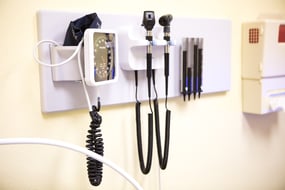Get the latest Vera news
Stay current on healthcare industry developments, Vera updates, in-depth resources, and interviews with Vera providers and other industry experts. Sign up to receive our newsletter.
By Vera Whole Health | Posted May 14, 2019 | Posted in Advanced Primary Care
Primary care has a long history, but that doesn't mean it's been perfected.
To get an honest opinion on the importance and future of primary care, we sat down with Dr. Jeffrey Steinbauer, Chief Medical Information Officer at the Baylor College of Medicine, and Dr. Stephen Spann, Founding Dean of The University of Houston College of Medicine.
They offer invaluable insights and experiences, as well as impressive commitment to raising awareness about the need to better utilize primary care. Read on for their thoughtful answers to our questions.
Dr. Steinbauer: I've been a practicing family doctor for 40 years. When I was in residency training, there was a really clear understanding that the primary care physician was the starting point for everything. Patients knew that; the specialists knew that. Some of them wouldn't see a patient unless they'd already seen their primary care doctor. And they were careful to send patients back to the primary care doctor.
And all of this occurred long before the need to have any sort of referrals or anything. People had insurance that would just let them go wherever they wanted to go. Over time, expectations changed. And part of that change occurred in the '90s when we went to the gatekeeper-model HMO.
At that point, it was mandated that patients had to see their primary care physician before they went to the specialist. Instead of being an asset, primary care became a barrier — perceived as an unnecessary step before the specialist.
"Well-trained primary care doctors can take care of 85% of their patients' problems without having to refer them."
Primary care has also become increasingly specialized and sub-specialized so that the number of primary care physicians that are available to see a patient has diminished. So if I'm a patient who is worried about chest pain, I might be able to see a cardiologist quicker than my primary care doctor because primary care is a diminishing resource.
Healthcare today has become a little like the fast food business — people want now, and they want it their way. If I'm a patient who has a backache, instead of going to primary care to get the workup started and at least figure out what’s going on, they want to see an orthopedic surgeon. This is a waste of time and money because the majority of back pain is non-surgical
So I think that there are also some lingering misconceptions about what primary care can do.
Dr. Spann: I think patients who experience great primary care and develop a strong relationship with a personal primary care provider value it enormously.
When I was at Baylor College of Medicine, a lot of my patients were Baylor faculty, or faculty from other universities. They valued the care I provided them. And most of the time, they wouldn't even think about seeing a specialist unless I recommended one to them.
So I think when primary care is done well, it's highly valued. The growth in concierge practice, which is basically primary care practice at a very intense level, is a great indicator.
Patients appreciate building relationships with primary care doctors and practices that deliver comprehensive care. But a lot of patients don't experience that.
Rather, many think primary care is going to an Urgent Care. That's their experience, what they know. And the problem is . . . that's just not primary care.

Dr. Steinbauer: Number one would be cost-effectiveness. If you come to my office with a sore throat and we do a strep screen and find out that you have a viral illness and not strep throat, I can make some recommendations and suggest you be off work for a day or two. The whole encounter is probably going to cost less than $150.
If you go to the emergency room and have the same thing done, it will probably cost you a minimum of $5,000. So the cost-effective nature of primary care has been shown over and over again to be really important.
Number two is relationship. When a patient has a personal relationship with primary care, they feel like somebody is looking out for them, somebody they can trust.
Today, there’s a relative lack of continuity. Patients bounce around from one primary care provider to another, one specialist to another. And often that's driven by changes in their health care plan and which network they're in. But there's nothing like having a longitudinal view of the patient's history or care journey.
I had a patient several years ago now, and he's still my patient, who came in because he was having one sinus infection after another. He was also getting asthma, which made it worse.
So I did a little digging and ended up diagnosing a very rare autoimmune condition, an inflammatory condition. I referred him to be placed under the care of a pulmonologist. But he has continued to follow up with me, and he was doing very well.
But if he had been going episodically to a different doctor over and over again, he probably wouldn't have ever gone deeper than a sinus infection diagnosis. The underlying disease probably would have been missed for a much longer period of time.
So I think the continuity of care and having somebody who understands you, your values, your goals, and your general health over a longer period of time is very valuable.
Lastly, as people get more and more diagnoses, you can almost develop a full-time job going from one specialist to another.
So imagine you have a little heart disease, a little high blood pressure, a little bit of diabetes. You've got a ruptured disk in your back and you've got a little bit of arthritis. With diabetes, you'll have an eye doctor. You could also have an endocrinologist, and even a cardiologist, you'd probably have a GI person who will periodically scope you to be sure you're healthy. You might also have an arthritis specialist.
My point is, you just accumulate a laundry list of specialists when only one primary care physician can follow most of those things and save you a whole lot of time and effort. I think that would probably be much more convenient for the patient.
Dr. Spann: It's higher quality care at low cost. That's the primary value. It's just better care at a low cost.
But how does someone experience that personally? I think in many ways it's one-stop shopping. At a global level, the evidence is that well-trained primary care doctors can take care of 85% of their patients' problems without having to refer them. There's continuity and relationship. Providers heal through relationships. That's the way we help patients to get better.
There's a vast literature showing patient trust in their physician is absolutely key to compliance and improvement.
I would emphasize also the paradigm in primary care, which is the biopsychosocial model. We don't divvy people up into physical, mental, social and spiritual dysfunction. We look at them as a whole.
A patient may come in to see me because of chronic low back pain. But it's really related to depression and not the intrinsic back pathology. However, I will treat the whole person. I will deal with the depression and the back pain. My commitment will be to get the patient well.
It's a unique approach; remember that 50% of problems that patients bring to their primary care doctors are not biological. They're psychosocial.
"Our system is not broken because we don't have good technology or good science. It's broken because we don't deliver it well."
There's also the opportunity for primary care to pay close attention to social determinants of health. And we now understand that somewhere between 60% and 80% of health issues in our country are preventable.
Morbidity and morality are related to social determinants of health. Only 20% of issues of preventable morbidity and mortality relate to medical care.
Our system is not broken because we don't have good technology or good science. It's broken because we don't deliver it well.
Dr. Steinbauer: Chronic disease management. When I was in training the idea was if I had somebody see a specialist, the specialist would call me and we'd meet and follow up on a patient’s care and establish a plan.
It would go something like this: the specialists would say, “I think Mr. Jones has A, B, and C. We should examine these three things.” Then I'd say, “I appreciate your feedback. I'll see Mr. Jones and if we're having problems, I'll let you know.”
So Mr. Jones would come back to me under my care, and the specialist would only be brought back in if the plan wasn't working or if we encountered problems along the way.
That’s the most effective use time and expertise. As a primary care provider, I’m trained to monitor a patient’s health on multiple fronts at the same time. I don’t worry just about one organ, I care about the patient as a whole person.
"Insurance companies have shaped our practices. Reimbursement patterns have changed the practice of primary care by determining what we can do in the office and what we have to refer out."
When I was in training, the goal was to be able to take care of 80 to 85% of every single problem that came through the door. And my referral rate reflected that. I didn't refer almost every patient that I saw for a second opinion or for a work up.
But the word has changed — certainly in urban areas where there's an abundance of specialists. And I'm referring patients a whole lot more because I have to.
I don't have the privileges to do colonoscopies myself anymore. Insurance companies don't reimburse me to take off skin lesions anymore. I used to do that all the time but now I have to refer them to dermatology because they won't pay, even though the outcome is the same. It would also be more cost effective if I did it. And better for the patient.
Insurance companies have shaped our practices. Reimbursement patterns have changed the practice of primary care by determining what we can do in the office and what we have to refer out. The number of procedures you see primary care doing in their office is far less than what it used to be even 15 to 20 years ago.
Dr. Spann: Time is another problem. It prevents providers from building a relationship with a patient. Having a broadly-trained physician is also an issue. And even broad healthcare team.
Part of this is medical education. For the most part, medical training takes place in tertiary, quaternary care medical centers, where the bulk of the faculty are so specialist and they don't understand primary care.
And medical students constantly hear, "You're too smart to be a primary care doctor. You need to go into my specialty." It's not malevolent or malicious. Specialists just don't have a clue about primary care.
In fact, to be a great generalist primary care provider is one of the most significant intellectual challenges in medicine, and one of the most satisfying careers.
There's also the issue with reimbursement. Remember that our medical students graduate with $190,000 in debt on the average. So when you can earn two or three times as much as a procedural specialist as you can as a primary care physician, some students vote with their wallets.
There's also a misperception that primary care practice is somehow more difficult, somehow more taxing than some specialty practice. And that's really not true.
"To be a great generalist primary care provider is one of the most significant intellectual challenges in medicine, and one of the most satisfying careers."
Some medical students perceive that primary care doctors are overstressed. But primary care is in an evolution. We're moving towards a much higher level of primary care as we understand the need to use care teams and to have every member of the team practice at the top of their license. It's slowly changing.
In an optimal world, primary care physicians would have more time with their patients. I think shorter visits are about economy. But that's why primary care providers tend to over-refer.
In an optimal world, a broad healthcare team will help make discovering a problem and finding a solution happen more effectively and efficiently.
Dr. Steinbauer: I’m absolutely on fire to see primary care incorporate all of the elements that have occurred in the last 10 years as trends, in terms of best practices. And one is to maximize our use of data to embrace electronic health records and utilize registries to track our quality.
We need to remodel primary care to reach out to patients ahead of time to be sure people are getting the screening they need. We need to change what we do in the office so that we're not just engaged with patients during an appointment, but then not thinking of them until they show up at the office again.
I think primary care physicians can develop a sense of continuity using data that assures that if you need regular care — they can and will be done on time because we'll reach out to you.
"I see a future full of possibility and opportunity. And I'm anxious to do my part."
Right now a primary care provider does so many things that he or she doesn't need to do because they don’t use the teams in their office effectively.
For example, I want to see people who are sick. Then I ought to have a whole team of people working with me who will do the health maintenance, routine follow-ups, and annual appointments.
So if a patient is really sick, and we can't figure out what's the matter with them, then I want to see them. That's who I want to take care of. That's what I trained to do.
We need to make a lot of strides towards redesigning our office teams and processes. But we also need to better utilize big data and our electronic health records to understand our entire practice population, improve our quality outcomes, and provide better access to patients.
I see a future full of possibility and opportunity. And I'm anxious to do my part.
Dr. Spann: First off, there would be more primary care physicians. And more medical students choosing primary care as a specialty choice.
Primary care providers would have better reimbursement, in a value-based reimbursement system.
We would be providing care through care teams, where everybody practices at the top of their license. We would also be using all the modern technologies we can to enhance what we do, like virtual visits, Telehealth, to provide great access to patients.
And our patients would be highly satisfied, and the value of healthcare in this country would be substantially increased. We would be delivering better care for less cost. That would be my dream.
Stay current on healthcare industry developments, Vera updates, in-depth resources, and interviews with Vera providers
Stay current on healthcare industry developments, Vera updates, in-depth resources, and interviews with Vera providers and other industry experts. Sign up to receive our newsletter.





